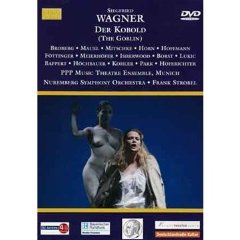Siegfried Wagner ‘s 1903 opera Der Kobold (The Goblin) is a fascinating yet infuriating work. It often seems as if both music and libretto were written by a committee that couldn’t come to agreement. The plot structure careens wildly from realism to mysticism to symbolism; the music hops from style to style and influence to influence until S. Wagner’s own stamp is hard to find.
The story is the journey of Verena, tormented by dreams of her illegitimate child who now appears to her as a goblin, searching for redemption. We learn that her own cruel mother killed Verena’s child, and there are dark hints of sexual abuse.
Verena, too, seeks redemption through love — though, as the song goes, she’s lookin’ in all the wrong places. Her journey involves a travelling troupe of actors, a mysterious old man named Eckhart, a devious and deviant Count and Countess, and a symbolic magic stone.
In the end, the Count’s henchmen, trying to kill her lover Friedrich, stab Verena. She dies, redeeming all the children’s souls. In the story and the music, one hears hints of Lohengrin (exactly the same first chord), Pelleas et Melisande, Elektra, The Ring, Parsifal, and, yes, Rosemary’s Baby.
It must be said that the opera contains some magnificent musical passages, particularly the orchestral interludes. The prelude to Act III is particularly complex, expressive, and beautiful. Verena’s song about a blind bird in Act I is lyrically lovely, and the Count’s music when he attempts to seduce Verena is particularly haunting and passionate. Much of Verena’s music in Act III, too, is melodic, emotionally clear, and inventive. Unfortunately, these sublime sections are surrounded by pedestrian and uninspired music (particularly in the sections involving the acting troupe), a derivative mess.
The production captured on DVD (Marco Polo MCPO 2220003), directed by Peter T. Pachl for Stadtttheater Furth with the Nuremberg Symphony Orchestra under Frank Strobel, doesn’t help matters. The difficult plot could have been illuminated by a production that looked for clarity, but here we have a heavy-handed attempt at psychological symbolism that only further obscures the story. A geometric “window” hangs in the middle of the stage, serving as a stage set for the actors and a portal through which dreams appear.
We are constantly assaulted with projections, evidently to show us the state of Verena’s mind (we couldn’t get that from the music?) — and, of course, they are the usual suspects: dark clouds, waterfalls, and peering eyes. One set of projections, apparently to set us for the Count’s house in Act II, involves a number of poodles romping about. Are we to think that the leather-clad Count and Countess are dog breeders on the side?
In the pivotal role of Verena, the production happily has the soprano Rebecca Broberg, who gives a nuanced, powerful performance. She is a capable actress and a most expressive singer throughout her range, with excellent phrasing and emotional clarity. I also much liked the dark-voiced Regina Mauel as Verena’s mother Gertrud, though her singing is limited to Act I. The rest of the large ensemble cast was successful in their acting, but the singing ranged from competent to barely tolerable.
It seems to me that this opera might better be approached by hearing an audio recording before viewing this DVD. I found it very difficult to let my imagination respond to the music drama while attempting to decipher so much visual clutter.







Comments